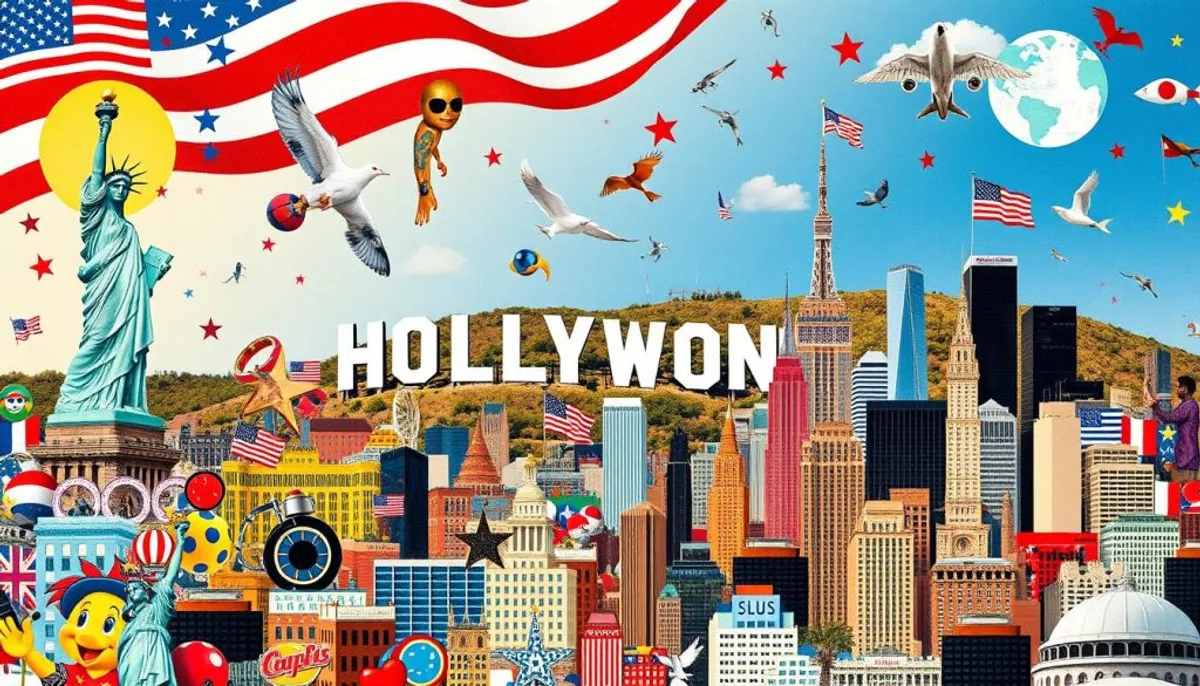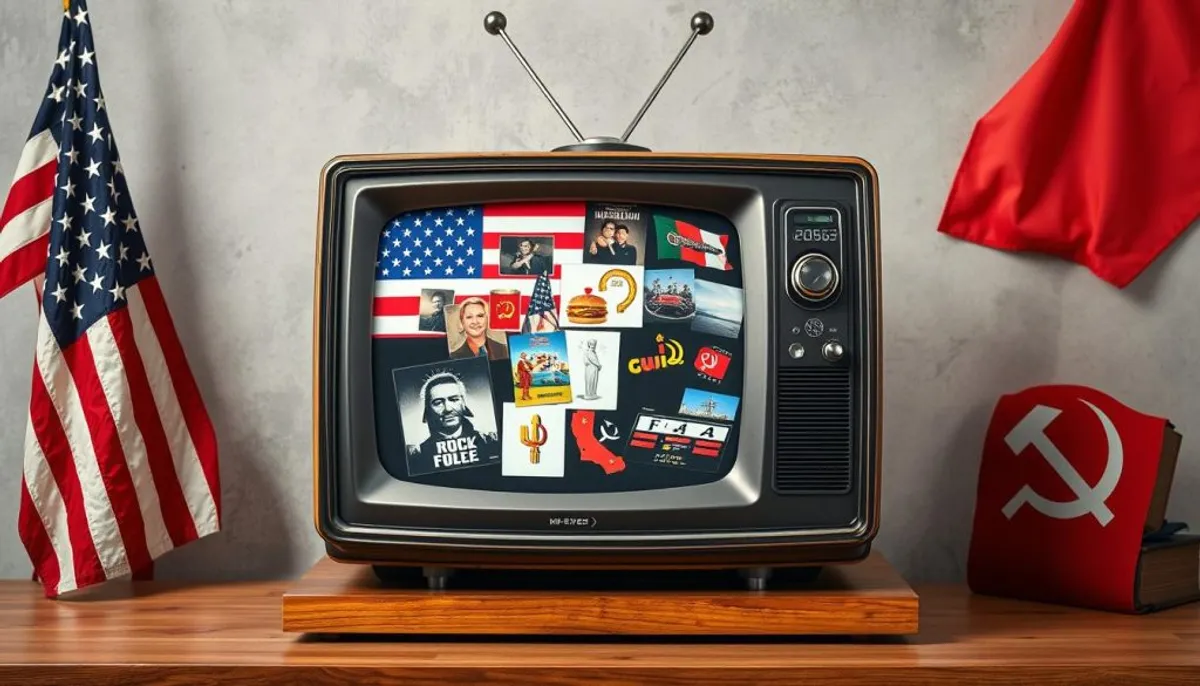The American cultural influence extends globally. This expansion, initiated after the Second World War, has profoundly marked our era. The American Way of Life, thanks to globalization, has established itself as a global societal model.

The American soft power unfolds in various fields. In 2013, 9 out of the 10 most viewed films in France came from the United States. This cinematic predominance illustrates the massive exportation of American culture. Moreover, English has become the dominant language of international exchanges.
The economic power of the United States has facilitated the spread of iconic brands. Coca-Cola, McDonald's, and jeans have become global symbols. The American dream, perceived through blockbusters with universal themes, continues to attract global attention.
The historical origins of American cultural dominance
The rise of the United States on the global stage has profoundly marked the history of the 20th century. This meteoric ascent finds its roots in the events following the Second World War.
The post-war period and the emergence of a superpower
After 1945, the United States stands as the undisputed leader of the Western world. Their cultural influence spreads rapidly, symbolized by icons such as Coca-Cola and chewing gum. This period sees the rise of English as the dominant language, according to Bernard Cassen, becoming a “hypercentral language” in the global linguistic system.
The massive diffusion during the Cold War
The Cold War marks a turning point in American cultural expansion. In the face of the USSR, the United States uses its culture as a tool of soft power. Hollywood becomes a powerful vector of the American dream, exporting its productions worldwide. This massive diffusion reinforces the idea of a unique and dominant culture.

The development of American mass media
The rise of American media plays a crucial role in this cultural dominance. Cinema, radio, and television facilitate the circulation of American ideas and values. Channels like CNN broadcast American ideology on a global scale, consolidating its influence in various fields.
| Period | Key Event | Cultural Impact |
|---|---|---|
| 1945-1950 | Post-war | Spread of American products |
| 1950-1991 | Cold War | Use of culture as a weapon |
| 1980-2000 | Rise of media | Global propagation of American ideology |
Why American culture dominates the world
The cultural dominance of the United States relies on three major pillars: the American economy, the English language, and soft power. These elements intertwine to create an unprecedented global influence.
The economic power as a driver of diffusion
The American economy, the world's largest with a GDP of 28 trillion dollars in 2024, propels US culture internationally. This economic strength allows the United States to massively export their products, services, and lifestyles.
| Country | GDP (in billions $) | Global Position |
|---|---|---|
| United States | 28,000 | 1 |
| China | 18,000 | 2 |
The influence of the English language
The English language, having become the lingua franca of international exchanges, reinforces American cultural hegemony. American universities, occupying 17 of the top 20 global spots, attract talent from around the world, consolidating this linguistic influence.
Soft power and means of communication
American soft power is exercised through American media, cinema, and music. Hollywood dominates the global film market with 50 to 80% market shares in developed countries. Digital giants like Google and Facebook amplify this cultural influence in the Internet age.
This combination of economic, linguistic, and media power explains the persistence of American cultural dominance, despite the rise of other nations like China.
The pillars of the American Way of Life
The American Way of Life, emblematic of American culture, rests on fundamental pillars. These have marked the world, influencing entertainment, gastronomy, and shaping lifestyles on a global scale. Their impact is profound, shaping typically American values and ideals.
Cinema and television series
Hollywood, a true dream factory, dominates the global box office. American productions capture the imagination of the international audience. They propagate values and typically American ideals. American series, widely broadcast, influence local cultures and viewing habits.

Popular music and trends
American pop music shines on the international stage. From jazz to rock to hip-hop, American artists shape global musical trends. This cultural dominance is explained by the power of American music industries and their ability to export their productions.
Gastronomy and consumption patterns
Fast food, emblematic of American fast food, has spread worldwide. Chains like McDonald's have become symbols of mass consumption in the American style. This consumption model has influenced global eating habits, transforming urban landscapes with the emergence of shopping centers inspired by the American model.
| Pillar | Global Impact |
|---|---|
| Cinema | Box office domination |
| TV Series | Influence on local cultures |
| Pop music | Global musical trends |
| Fast food | Transformation of eating habits |
The impact of digital on cultural dominance
The digital revolution has propelled American culture to new heights, thereby reinforcing American cultural hegemony. The giants of Silicon Valley have transformed our way of communicating, consuming, and entertaining ourselves.
The giants of Silicon Valley
The GAFA (Google, Apple, Facebook, Amazon) dominate the global digital economy. Their influence extends far beyond American borders, shaping the global digital culture. These companies, with market capitalizations exceeding the GDP of many countries, dictate technological and cultural trends.
American social networks
Facebook, Twitter, and Instagram have become global communication platforms. These American social networks influence opinions, fashions, and behaviors on a planetary scale. They play a crucial role in the dissemination of American culture and the creation of global trends.
The hegemony of streaming platforms
Netflix and Spotify, leaders in streaming, massively distribute American cultural content. These platforms have revolutionized media consumption, reinforcing the omnipresence of American culture in our daily lives. Their success raises questions about cultural diversity and the digital sovereignty of other nations.
| Platform | Users (millions) | American Content (%) |
|---|---|---|
| Netflix | 231 | 60 |
| Spotify | 422 | 55 |
| Disney+ | 152 | 70 |
Conclusion
American cultural hegemony has been built over several decades, revolutionizing our world. Since 1945, the United States has extended its influence across all continents. They have employed various means to consolidate their dominance, touching the economy, politics, and military aspects of many countries.
Globalization has accentuated this trend. The statistics are telling: over 80% of global audiovisual productions come from the United States. American music generates billions of dollars, dominating Spotify playlists worldwide. The giants of Silicon Valley dominate the digital world, disseminating American values through social networks.
The question of cultural diversity becomes crucial in the face of this omnipresence. Cultural resistances are emerging in some countries, aiming to preserve their traditions against Americanization. The balance between cultural homogenization and the diversity of local identities is a major issue. This debate is at the heart of reflections on our globalized world, where American influence continues to shape our daily lives.
RelatedRelated articles


